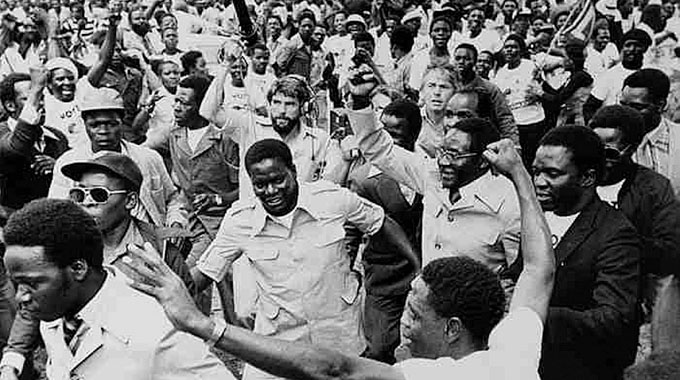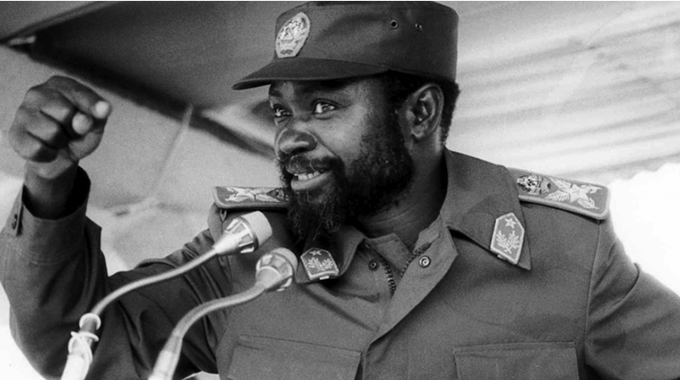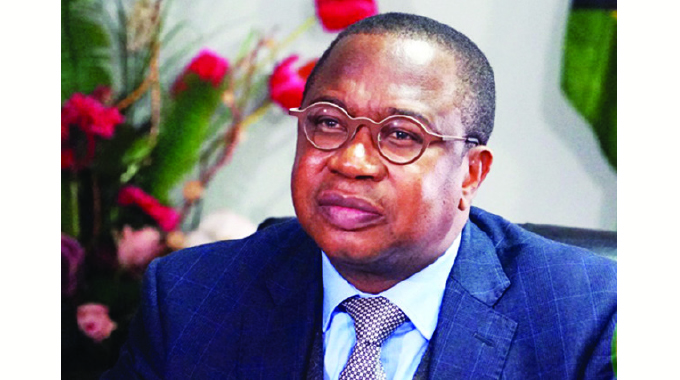@JAMWANDA2 ON SATURDAY – Chamisa: Sowing wild political oats

@JAMWANDA2 ON SATURDAY
The war which never ended
There is a narrative reigning in opposition circles. It says all stories related to the Liberation Struggle are stale and sterile, indeed some self-titillation by a dying generation seeking to cheat time and extort past glory against present failures.
This is hardly surprising. After Tsvangirai and his generation in opposition, Triple C today is now a place for high school and college yobs who, apart from not having been born at the time of conclusion of the Armed Liberation Struggle, have wilfully adopted pro-Western politics reeking with a strong anti-liberation struggle ethos.
They have not cared to bend down low, so elders of this Land tell them what they should know. Or even to read the story of our Nation which escaped them existentially. This is why they think the Liberation War – any war for that matter – has had a clean closure, placing it behind us.
They have not travelled even, to theatres of the real war so they see signs and symptoms of a long war which rages on, some 43 long years after the shooting stopped.
Placing blame on Zanu PF
Zanu PF is also to blame. Unlike glorious winners of wars in history, Zanu PF reticently takes the posture of a loser of a war it won. It has failed to re-narrativise and panegyrise in any systematic way, so important a war which in fact is a founding process and myth of the Nation it rules. There is little understand that after wars make countries, history and myths make Nations!
History as a ghost for incantations
Zimbabwe is a Nation which stands on shards of history, on shameful historical anecdotes; it is still to find its own readable history and histories, if history is understood to refer to a systematic rendition of a liveable, usable past. Liveable in that history’s tissue carries the DNA of the present and future of any People, any Nation; that indeed history is a ghost that needs constant evocation and incantations, so it reincarnates among the living, and in long posterity.

King Charles III
Getting a wayward opposition it deserves
Usable in that history is a key raw material for understanding and tackling today and tomorrow’s problems. Societies which take history seriously, which treat history as liveable and usable, re-enact it in monuments and classrooms, themselves visual and silent foundries for moulding posterity.
On that score, Zanu PF has been an abject failure, which is why it gets a wayward opposition it deserves! Until this changes – which is to say – until Zanu PF accepts and embraces its historic mission to re-narrativise and mythify its painful Struggle, mythify the victory it won, it remains fated to get the wretched anti-nation opposition personified by the likes of Chamisa and Biti, who will forever be fired and legitimised by Rhodesia’s ever-swelling historiography, so full of hyperbole and colour, yet daily reshaping outlooks.
History in built environments
Yesterday as I drove all the way to Nyamapanda Border Post, and then South-eastwards along the once notorious Binya Road, all the way to Rwenya River Bridge, I kept reminding a workmate that the roadside built-environment along the Highway to Nyamapanda, remains a veritable yet untapped source of primary historical data on our Armed Liberation Struggle.
It holds stories that remain unheard, uninterpreted as our children read and rote-learn Julius Caesar and Winston Churchill!
He looked bemused, understandably. He is what Salman Rushdie would call “a midnight child”, having been born of the eve of our Independence, and thus with one foot in settler colonial Rhodesia he never experienced, and another in our Zimbabwe, the only country he has grown under and lived as a conscious human being.

Dan Stannard
I explained the riddle, as I do so now to multitudes like him who live nowadays, and who now outnumber us, a generation reared under fires of a very harsh and cruel war.
Deadly to live along Highways, roads
Living along the highway then, or along any Rhodesian road for that matter, was a stupendous hazard during the Liberation Struggle. The Rhodesian soldiers would come for such homesteads and their denizens, as they went about their operations. Or more harshly if they suffered an ambush or a landmine explosion along the way. Or both.
Homesteads would be torched and razed to the ground, with their owners getting roughened and rounded up for incarceration. Or worse, killed in cold blood. Families who were still free, relocated further away from roads and highways, preferably to live in the fastness of remote hills and mountains, far away from the reach of Rhodesian soldiers. Homes were abandoned to time and termites.
Quartered in concentration camps
Or less fortunate communities that had long been rounded up from their traditional homes to be quartered in Concentration Camps: what Rhodesians euphemistically called Keeps, without any tinge of irony.
They lived under the settler gun, guarded by District Assistants, notorious DAs for short. You do not need to go very far to catch sight of sites of such forced settlements. Just go as nearby as Nzvimbo area in Mashonaland Central just a few kilometres after Glendale; you will see the dunes which still give a clear outline of the perimeter of defensive ramparts these settlements depended on vainly to ward off attacks from liberation fighters.

A concentration camp in mRhodesia
All that is part of a war wrought in architecture, in our built environment which historians are yet to decipher.
Architecture as history source book
Along the aforesaid Highway to Nyamapanda, you will notice that most homesteads are fairly recently built, in fact built after 1980 when peace returned to our Land. You also see contour ridges running diagonally away from the Highway, mostly now overgrown with big trees.
These used to be sites of pre-war African settlements under colonial Rhodesia. Here and there, you see ruined structures of old roundavels; these are markers of life once lived, before the War of Liberation started and intensified. What you now see along the Highway are post-war reconstructions, which is why most structures are relatively new, and graced with modern roofs which only very few African Rhodesian could afford before Independence.
Only houses of madhumeni naana muhodhari, and other rural-based colonial functionaries, would have rectangular brick structures, usually typically under red zinc roofs. Such was the life then, the life some of us lived and suffered, which the current generation cannot even begin to visualise, let alone read from.
We should not be too hard on them; we are at fault. We did not tell the story at all. Or long and repeated enough for it to stick. It is not too late!
The way called Binya Road
Nyamapanda and Rwenya are connected by a dirty ring-road which the Rhodesians hastily built to aid their operations against Freedom Fighters.
Mudzi, home to Nyamapanda, borders Mozambique. As far as 1973/74, Frelimo, the fighting Liberation Movement in Mozambique – Portuguese East Africa then – had agreed to embed units of ZANLA fighters within its ranks, nominally to help liberate Tete Province, which is contiguous to Zimbabwe, fundamentally to open a new front and routes into Rhodesia for the escalation of our Liberation Struggle.
This decision made sense. Rhodesians supported the Salazar Government in fighting Frelimo in Mozambique, which is what Frelimo had an interest in facilitating a force into Rhodesia, to pin the Rhodesians down in Zimbabwe so they would stop their cross-border support to the Portuguese.
Barely a year later, in 1974, Portugal lost the war in Mozambique, catalysed by a coup which ousted the “mother” Government in Portugal. Frelimo moved in, under an interim arrangement which then yielded Independence on 25 June, 1975.
Acts in desperation
Between 1974 and 1978, desperate Rhodesians tried many ways of creating a cardon sanitaire along Zimbabwe’s long border with Mozambique, a country by then decolonised and free under the radical President Samora Machel.
They built a ring-road which they dubbed Binya road, to run parallel to the border, and designed to aid motorised deployments and operations against both Zanla and Zipra guerrillas.

The late Samora Machel
Binya in the double sense of its intended purpose, namely to dam the flow of guerrillas, and in the sense that it became treacherous from deadly guerrilla ambushes and landmines.
That road covers at least four Provinces, namely Mashonaland Central, Mashonaland East, Manicaland, parts of Masvingo and bits of Matabeleland South.
Mining the Land
The next desperate move by Rhodesians was to mine huge swathes of land from our border with Mozambique towards the outer shoulders of Binya Road. The idea was to create a deadly buffer zone which would stop guerrillas from crossing into Zimbabwe.
That never worked for, where there is a war, there is always a way! And because the land to the left along Binya Road, as one runs southward, is heavily mined, there are very few human settlements on the Zimbabwean side, except in areas now de-mined. Even the land to the immediate right of the road remains thinly settled and tilled, for the reasons already tendered. Again this sparsely built environment is an open book yet to be read.
The War continues
In Mudzi District, as in many districts along our borders with Mozambique, Zambia and to some extent Botswana, the Liberation War continues, four decades after the shooting stopped.
The Rhodesian anti-personnel mines continue with their grim harvest: of man, women, school children and animals, the persistent cross-generational targets of a war which goes on long after it ended! I visited a camp of a de-mining company supported by the British Government; it is called MAG: Mines Advisory Group.
There are over 40 de-miners, the majority of them who are trained locals who have joined in the assignment of such tremendous danger and hazard. They have images of what these mines have done to human limbs. The visuals are heart-wrenching. I was particularly struck by the dangling foot of a villager whose whole leg was shattered by a mine: the foot dangled at a hapless, reckless angle from its detached heel, leaving the shin legless. A terrible sight which forces you to look away.
A deadly donation from countries which don’t care
I asked after the identity of the anti-personnel mines. They were largely manufactured in South Africa, Italy and Germany.
All these three countries have nothing to do with the ongoing de-mining exercise, even though the deadly legacy is their aid to us who live into Independence. Who says the war is over? Or speaks of a vain attempt to rekindle dead glory by a failed generation?
I really wish our opposition would pay a visit to the affected areas; and watch the four de-mining companies – including our ZNA – painstakingly go through the hazardous and arduous work of clearing these mine-infested areas.
You have to be heartless to say the war is over; without a heart not to shed a tear. Yes, beastly to befriend forces which mined our Land, borrow or even recreate the politics which motivated them to embark on such a deadly, lasting assignment. Zimbabwe, know thyself!
The King who pulled down the Union Jack
I was in London for the Coronation of King Charles III. Not many know that it was Prince Charles who pulled down the Union Jack on the eve of 18th April, 1980, to make way for the flag of a newly Independent Zimbabwe, which late General Chimombe – wartime name Agnew Kambeu – handed over to late President Mugabe, then Prime Minister. The current President was Minister of State Security. There is an iconic picture of the current President, Dr ED Mnangagwa, late General Mujuru and late Shungu, protecting the late President on the day, in Rufaro Stadium, amidst a huge crowd.
The day Rhodesians would have killed future King
What many Zimbabweans have never known until now is that Rhodesians had planned to blow up the whole leadership, together with Prince Charles and all visiting heads of several foreign countries, on the day.
Rhodesians had created a roaster of explosives on either side along the road leading into Rufaro, all of them disguised as lampposts. The idea was to blast successive motorcades once they were in the killing zone.
A Russian-made missile had also been mounted at the Harare Kopje, ready to complete the deadly assignment. A Rhodesian intelligence officer, named Dan Stannard, exposed the deadly conspiracy to the current President, then as State Security Minister.
This is how the annihilation was averted. There is again an iconic picture where the current President is examining the Russian-made missile which would have been used on that fateful night.
Dan Stannard, who passed on a few weeks ago, later became CIO Director Internal, DIN in the language of the industry. He got the highest award on his retirement in early nineties.
Father forgive them . . .
As I read opposition drivel deriding President ED Mnangagwa’s recent Coronation visit to the United Kingdom, I just look away in despair, sighing: all ye men and women of little knowledge and history!
Chamisa and his lot are mere boys of tears, kindergarten political upstarts who never know how the country they aspire to govern came about. Or who did what in its midwifery. Above all, what acquaintances and lasting friendships were struck on that wonderful yet menacing night when Zimbabwe was born.
Only under President ED Mnangagwa
Arising from that, they do not know what they are up against, as the 2023 harmonised polls loom so menacingly close. ED had to be there as King Charles was being crowned. You have to be a fool, plus an a-historical, ahooyi-imbued college politician not to know why and how.
Or not to read the signs so legibly written in large letters, both here at home, and there abroad where Triple C thinks it still holds sway! Relations between Zimbabwe and the United Kingdom can only change under President Mnangagwa.
Someone must whisper to Chamisa – mukwambo wangu – that while he enjoys his dalliance with Lord Jonathan Oates, himself slightly older – that while he is busy sowing wild oats with useless Britons, real Britain has since long moved on, with EU in close tag. Between now and elections which are set for August, and a few weeks, months soon after, Zimbabwe will never be the same again. Let me stop this pregnant bray; I am only a donkey!









Comments